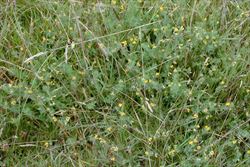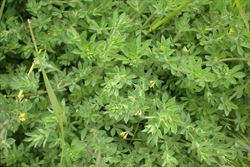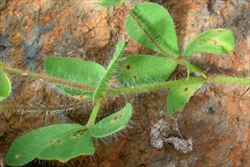Click on images to enlarge

infestation in a grassland (Photo: Forest and Kim Starr, USGS)

habit (Photo: Sheldon Navie)

leaves and flowers (Photo: Sheldon Navie)

close-up of hairy stems and leaves (Photo: Forest and Kim Starr, USGS)

close-up of flowers (Photo: Forest and Kim Starr, USGS)

immature fruit (Photo: Sheldon Navie)

close-up of mature fruit (Photo: Forest and Kim Starr, USGS)
Scientific Name
Lotus subbiflorus Lag.
Synonyms
Lotus hispidus Desf. ex DC.Lotus suaveolens Pers.
Family
Fabaceae (Queensland, the ACT, Victoria, Tasmania, and the Northern Territory)Fabaceae: sub-family Faboideae (New South Wales)Leguminosae (South Australia)Papilionaceae (Western Australia)
Common Names
Boyd's clover, hairy bird's foot trefoil, hairy bird's-foot trefoil, hairy birdsfoot trefoil
Origin
Native to northern Africa (i.e. northern Algeria, northern Libya, Morocco and Tunisia), the Azores, the Madeira Islands, western and southern Europe (i.e. Ireland, the UK, France, Portugal, Spain, Greece, Italy and Yugoslavia) and western Asia.
Naturalised Distribution
Widely naturalised in southern and eastern Australia. It is most common and widespread in eastern New South Wales, Victoria, Tasmania, south-eastern South Australia and south-western Western Australia. Also naturalised on the Eyre Peninsula in southern South Australia and in the cooler parts of south-eastern Queensland.
Notes
Hairy bird's-foot trefoil (Lotus subbiflorus) was introduced into Australia as a pasture plant, and has become a weed of roadsides, pastures, disturbed sites, waste areas and footpaths mainly in the temperate regions of Australia. It also invades grasslands, wetlands, swamps, riparian vegetation and coastal environs, and is regarded as an environmental weed in Victoria and Western Australia.
In Victoria, hairy bird's-foot trefoil (Lotus subbiflorus) is regarded as a serious threat to one or more plant communities. This species is a common weed of coastal headland scrublands, coastal tussock grasslands, swampy riparian woodlands, South Gippsland plains grassland and swamp scrub vegetation in this state. It also appears on local and regional environmental weed lists (e.g. in Knox City and the Goulburn Broken Catchment) and is present in several conservation areas (e.g. Morwell National Park, Phillip Island Nature Park and Kinglake National Park) in Victoria.
In Western Australia, hairy bird's-foot trefoil (Lotus subbiflorus) is a widespread weed of creek flats, road verges, winter-wet areas, disturbed natural vegetation and relatively intact native vegetation from Geraldton to Esperance. It is also a commonly recorded weed species in wetlands on the Fleurieu Peninsula in south-eastern South Australia, and has been recorded from several conservation areas in this state too (e.g. Kyeema Conservation Park, Cox Scrub Conservation Park and Scott Creek Conservation Park).

